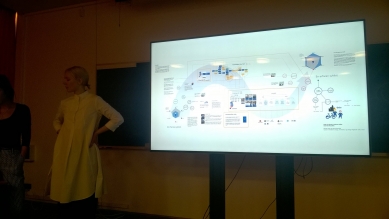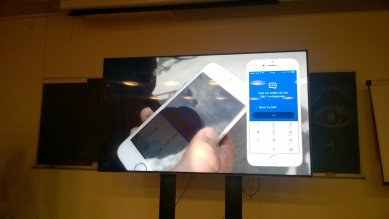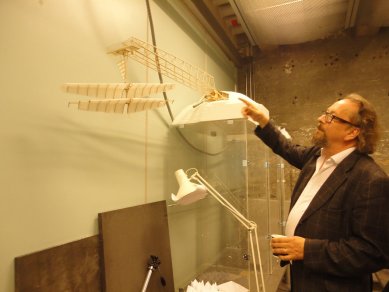
Project Systemic Approach to Architectural Performance
Visit to Oslo School of Architecture and Design
Within the framework of the institutional cooperation project, we, along with FUA TUL (FUA TUL, 2016), set out to visit the Oslo School of Architecture and Design (Oslo School of Architecture and Design, 2016). After a tour of the school, where the most impressive workshops for one-to-one scale prototype production were located, we participated in the final critiques at the design institute. Designers utilized Systems Oriented Design (Sevaldson, 2013) with GIGA-mapping (Sevaldson, 2016a, 2016b), consulted by Birger Sevaldson, for example, for urban applications aimed at city cycling. We were particularly struck by the interdisciplinary approach within the "service design" field, which addresses projects from interaction design to urbanism. One application, for example, taught beginner cyclists how to ride in the city, including safe routes and traffic regulations. This was all connected to social networks, where experienced cyclists can help, and there is an option to tag dangerous places with advice for solutions.
Furthermore, we visited the studio of Søren Sørensen and Michael Hensel. The studio focuses on so-called Performance Oriented Architecture (M. U. Hensel, 2015), that is, architecture that responds to its environment. The studio uses real-time data for its design, measured directly on-site. They also employ Virtual Reality to work with data. Generally, this studio creates urban or landscape interventions at full scale (M. Hensel & Sørensen, 2016; M. U. Hensel & Sørensen, 2014).
Unfortunately, we have little experience with such systematic design here. Most architectural objects are presented as aesthetic sculptures, and that is also how they are required. The major pioneers addressing these issues are mostly non-profit organizations in our country, while in Norway, such an approach has commercial clientele.
References:
EEA and Norway Grants. (2016). EEA and Norway Grants. Retrieved March 29, 2016, from http://eeagrants.org/
FUA TUL. (2016). Faculty of Art and Architecture, Technical University of Liberec. Retrieved April 2, 2016, from http://www.fua.tul.cz/
Hensel, M., & Sørensen, S. S. (2016). Research Centre for Architecture and Tectonics. Retrieved April 3, 2016, from http://www.rcat.no/
Hensel, M. U. (2015). Performance-Oriented Design. Retrieved April 3, 2016, from http://www.performanceorienteddesign.net/
Hensel, M. U., & Sørensen, S. S. (2014). Intersecting Knowledge Fields and Integrating Data-Driven Computational Design en Route to Performance-Oriented and Intensely Local Architectures. FOOTPRINT, 8(2), 59–74. Retrieved from http://footprint.tudelft.nl/index.php/footprint/article/view/812
Oslo School of Architecture and Design. (2016). Oslo School of Architecture and Design. Retrieved April 3, 2016, from https://aho.no/
Sevaldson, B. (2013). Systems Oriented Design. Retrieved October 1, 2013, from http://www.systemsorienteddesign.net/
Sevaldson, B. (2016a). GIGA-mapping Information. Retrieved March 29, 2016, from http://www.systemsorienteddesign.net/index.php/giga-mapping/giga-mapping-information
Sevaldson, B. (2016b). GIGA-maps Samples. Retrieved April 15, 2016, from http://systemsorienteddesign.net/index.php/giga-mapping/giga-mapping-samples
More information >
Furthermore, we visited the studio of Søren Sørensen and Michael Hensel. The studio focuses on so-called Performance Oriented Architecture (M. U. Hensel, 2015), that is, architecture that responds to its environment. The studio uses real-time data for its design, measured directly on-site. They also employ Virtual Reality to work with data. Generally, this studio creates urban or landscape interventions at full scale (M. Hensel & Sørensen, 2016; M. U. Hensel & Sørensen, 2014).
Unfortunately, we have little experience with such systematic design here. Most architectural objects are presented as aesthetic sculptures, and that is also how they are required. The major pioneers addressing these issues are mostly non-profit organizations in our country, while in Norway, such an approach has commercial clientele.
This project was kindly supported by the EEA and Norway Grants (EEA and Norway Grants, 2016).
References:
EEA and Norway Grants. (2016). EEA and Norway Grants. Retrieved March 29, 2016, from http://eeagrants.org/
FUA TUL. (2016). Faculty of Art and Architecture, Technical University of Liberec. Retrieved April 2, 2016, from http://www.fua.tul.cz/
Hensel, M., & Sørensen, S. S. (2016). Research Centre for Architecture and Tectonics. Retrieved April 3, 2016, from http://www.rcat.no/
Hensel, M. U. (2015). Performance-Oriented Design. Retrieved April 3, 2016, from http://www.performanceorienteddesign.net/
Hensel, M. U., & Sørensen, S. S. (2014). Intersecting Knowledge Fields and Integrating Data-Driven Computational Design en Route to Performance-Oriented and Intensely Local Architectures. FOOTPRINT, 8(2), 59–74. Retrieved from http://footprint.tudelft.nl/index.php/footprint/article/view/812
Oslo School of Architecture and Design. (2016). Oslo School of Architecture and Design. Retrieved April 3, 2016, from https://aho.no/
Sevaldson, B. (2013). Systems Oriented Design. Retrieved October 1, 2013, from http://www.systemsorienteddesign.net/
Sevaldson, B. (2016a). GIGA-mapping Information. Retrieved March 29, 2016, from http://www.systemsorienteddesign.net/index.php/giga-mapping/giga-mapping-information
Sevaldson, B. (2016b). GIGA-maps Samples. Retrieved April 15, 2016, from http://systemsorienteddesign.net/index.php/giga-mapping/giga-mapping-samples
More information >
The English translation is powered by AI tool. Switch to Czech to view the original text source.




Related articles
0
23.06.2016 | Architecture and Its Environment: Reflections on Michael Hensel's Lecture
0
13.03.2016 | Message from the workshop with Birger Sevaldson at FUA TUL
0
10.06.2014 | EnviroCity - invitation to the summer festival on public space
0
04.07.2013 | Mobius – pareSITE: Environmental Summer Pavilion











